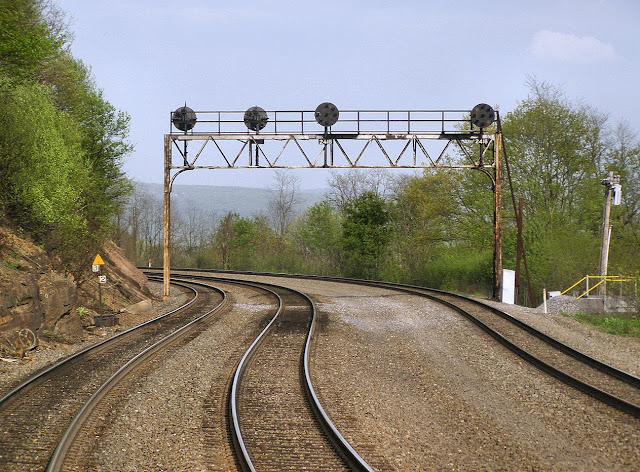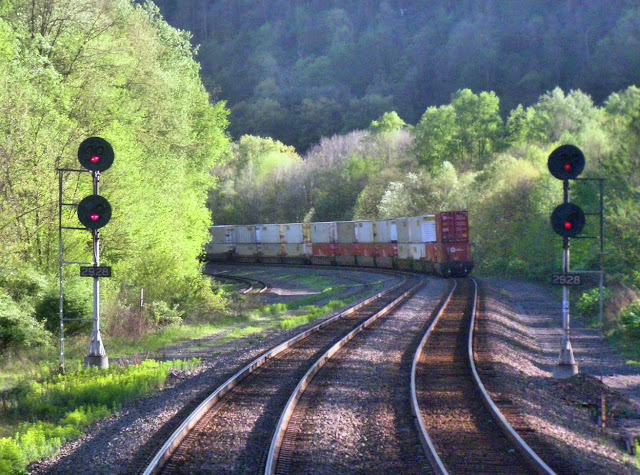So finally we come to the third, final and climactic part of my trip on the PRR Main Line between Philly and Pittsburgh last May where we will battle up the east slope of the Allegheny front via the world famous Horseshoe curve, crest the summit at Gallitzin, head down the western slope to the city of Johnstown, cut through the mountains along the Conemaugh River then race through the homes of Fred Rogers, Rolling Rock beer and US Steel on the final road to Pittsburgh.
The photos can be found in Chronibetical order here so its easy for you to follow along and look at some of the other non-featured photos. Also a 1990's Conrail ETT of the line can be found here, also to help with following along.
So as we leave Altoona we pass through CP-SLOPE, which anyone who read my ALTO tower essay will remember is remote control from there. It is in service only on 1 and 2 track and in the middle is a popular railfan bridge. You can already see the grade as we begin to battle up the east slope.
The asshats at NS have been on a bit of a Position Light removal binge on the Eastern Slope. It wasn't even part of a re-signaling effort :-( Here is a particularly ungainly looking cantilever at MP 239.
The MP 241 signal bridge was the one you used to be able to see from the Horseshoe Curve. I was lucky to get some good photos of it before it was replaced last summer. You would have thought they would have tried to keep this on intact due to its historical significance or at least solicited for donations to achieve the same end.
This is the change in elevation around the Horseshoe Curve. Pretty impressive.
It was a pretty good crowd in the park and we did our part by being roughly on time. A GP-9 replaced the K-4 guardian that stood there a few decades ago. Not sure what that little hut trackside is. I will admit that taking pictures out the back of the train tends to break down on the Horseshoe Curve.
If you remember that elevation difference picture a few back my train is now at that point with the MP 242 signal bridge, also probably replaced by now.
MG tower was built during the war to increase capacity on the curve. The tower design is unique today, but mimicked several others on the East Slope built around the turn of the 20th century. It was closed in 1994 as the segment between ALTO and C towers was changed from the old block system to CTC.
A three pack of GE's with a C40-9W, C40-8W and a C40-10W turn up the dynamic breaking as they begin their trip down the east slope on three track.
This flyover marks the location of the old SF interlocking where the line from the Muleshoe Curve joined. Yes there were two curves up the mountain back in the day, but the Muneshoe was more of a relief line and never got as much press as its bigger brother. Today its a rail train.
Here we are at the high point of the Pennsylvania Railroad, 2167 feet above Sea Level (which is approximately the height of MP 0 at Suburban Station, 248 miles to the east. There are three tunnels, Gallitzin and Allegheny shown here, and the New Portage which handles 3 track a bit to the south. The Gallitzin tunnel is the newest and was taken out of service when the Allegheny was enlarged for doublestacks. The New Portage tunnel was built for the Main Line of Public Works canal system.
CP-UN on 2 and 3 track is there the loop track connecting 3 track joins up. This loop track, a rarity in North American freight railroading, allows helpers or excursion trains to circle around and head back to Altoona.
CP-MO provides access to the helper base at Creson, PA. Cresson features a popular railfan park and even a railfan themed Bed and Breakfast. When MO tower was closed in 1994 efforts were made to preserve it, but the centure old wooden structure fall apart as it was attempted to be moved and had to be completely demolished. Between here and CP-AR/UN the line retains the 5-track alignment from PRR days.
The Cassandra Cut and its slide fences is another popular railfan location, with photographers using the bridge in the background.
This road bridge/signal bridge is another popular railfan location, seen here with a mixed freight.
On the rear end of the freight is a standard helper set of SD40's #3338 and #3337.
This wacky signal was modified when PennDoT plunked a road bridge down in the sight lines of the position lights as originally mounted. See, it works! Needless to day it its a popular railfan location.
CP-SO was completely rebuilt in 1994 along with the other interlockings between ALTO and C, but its tower survived until November 2008 when it was set on fire by local vandals ironically the night before I passed by on my 2008 PRR Main Line trip. The debris was still there nearly 6 months later.
The line between CP-SO and C tower follows the route of the Johnstown Flood. It was re-signaled once in the 90's when the towers were closed and then re-signaled again by NS to bring bi-directional operation to all 3 tracks.
A pair of brand new 4000hp EMD SD70M-2's head a heavy coal train up the West Slope.
On the rear were two helper sets making what local railfans call a "four-banger". So this coal train has 8000hp of road power and 12,000hp of helper power.
C(onemaugh) tower in Johnstown was the alanog to ALTO on the west slope routing through trains and attaching helper sets to them as well as local yard operations via its remote interlocking CP-AO and CP-JW. C tower was closed between 2003 and 2005 leaving ALTO as the only remaining manned tower on the Pittsburgh Line. C was built in the 1950's to replace a wooden tower damaged in a derailment. The Model 14 interlocking machine was retained until it closed.
The eastbound signals at C were replaced during the Conrail era. Here we see C interlocking and the Johnstown helper base with a helper set laying over.
The Johnstown station is an island platform serving 2 and 3 track. Most trains use 2 track as 3 track takes the "Slow Route" on the far side of the river which adds 15 minutes to the running time. A post-war PRR signal bridge sits at the west end of the station governing movements on 2 and 3 track.
Johnstown has learned its lessons and is now amply prepared for another flood.
An SD70M-2 sits at the westbound #3 track signal at CP-CONPIT as my train races through on #2 track. This is marks the end of three track operations on the Pittsburgh Line, the third track will continue on as the low grade Conemaugh Line. Note the 'C' boards on the signals as the Conemaugh Line uses Rule 562 operation without fixed wayside signals. This was installed by the PRR and was the first such major installation of its kind.
The stacks of the Conemaugh generating Station forms a backdrop to CP-CONPIT. The interlocking is aptly named as it forms the junction of the Conemaugh Line (left) and the Pittsburgh Line (right). The line between Johnstown and Pittsburgh was re-signaled during the early Conrail and Penn Central period.
The railroad was mighty crowded at CP-CONPIT as this eastbound doublestack train was routed through the plant on track #1 seen here at the point the Conemaugh Line splits off on its own alignment. There was also 4th train in the picture as an eastbound on the Conemaugh Line approached the stop back at CP-CONPIT.
The eastbound signals at CP-PACK have Slide Protection markers for the slide fences in the preceeding two miles.
Just east of Latrobe I found another PRR signal bridge had been lost. :-(
The Latrobe Station is still much as it was in PRR days.
CP-TROBE recently had its pneumatic point machines replaced with electrics. The eastbound signal gantry has also seen a visit from the OSHA man.
The girder signal bridge in Greensburg dates from the Penn Central days.
The Greensburg station consisted of two island platforms, but the construction of a new road bridge has blocked off the two side track alignments. Like Latrobe and Johnstown the station building is at a lower level to provide for under track platform access on the busy main line.
Another Roadrailer train passes as my train departed Greensburg.
CP-RADE is the next interlocking just south of Greensburg in Radebaugh, PA. It was getting late and I was starting to lose the light at this point.
CP-TRAFF is the eastern entrance to the former PRR Pitcairn Yard, which is now an intermodal terminal.
At CP-WING I was passed by a COFC train coming off the Port Perry branch which bypassed the Main Line route through downtown Pittsburgh.
At some point after 1994 the right of way into Pittsburgh was truncated by a....::sigh::...busway. This not only killed some position light block signals, but also hopes to use the line for commuter rail or heavy rail transit.
CP-HOME is the wye track is located where the Pennsylvanian trainsets turn before being stored overnight for the trip east. Only the east and north legs of the wye are interlocked.
As the busway killed the position lights I am not sure why NS had to re-replace the signals in the early 2000s. Also is that a private vehicle on the busway??
CP-BLOOM is where the Capitol Limited changes over to the B&O main line to Washington DC. Note the CPL in the background. The Cap is almost the only train to use this route.
About a half mile west is CP-EAST PITT where the cab signal territory ends. It is the last crossover before the Pittsburgh station.
CP-PITT is in service only on #1 track and controls the two station tracks and what used to be a short siding track in the station. There are sometimes helper sets hanging out on these various tracks.
And that's it, I reached my destination of Pittsburgh 353 miles from Suburban Station in Philadelphia. At the former WEST PITT interlocking (not shown) the millage will reset back to zero as travelers transition from the old Lines East to Lines West and enter the Fort Wayne Line en route to Chicago.
Well thanks to all who hung in there to enjoy the my entire 600 photo set of the PRR Main Line. Comments are very appreciated as processing the pictures and writing the essays are EXTREMELY time consuming.
I have a parallel series of essays that detail the trip from a signaling perspective I have posted on a signaling related blog.
Next time stay tuned for a trip on the Pittsburgh Light rail's 47L Library.












































No comments:
Post a Comment